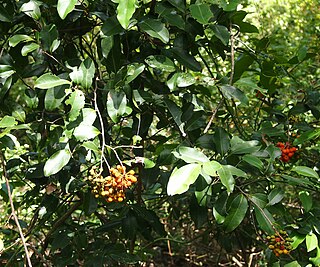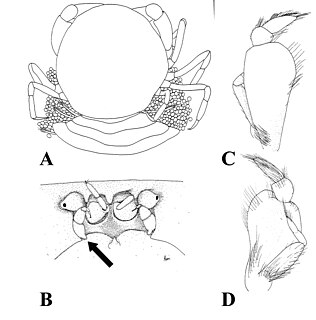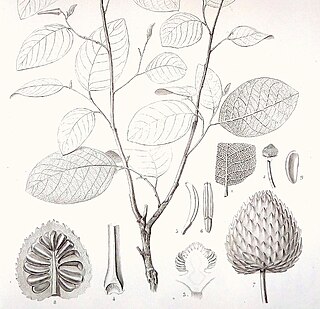
The Annonaceae are a family of flowering plants consisting of trees, shrubs, or rarely lianas commonly known as the custard apple family or soursop family. With 108 accepted genera and about 2400 known species, it is the largest family in the Magnoliales. Several genera produce edible fruit, most notably Annona, Anonidium, Asimina, Rollinia, and Uvaria. Its type genus is Annona. The family is concentrated in the tropics, with few species found in temperate regions. About 900 species are Neotropical, 450 are Afrotropical, and the remaining are Indomalayan.

Annona squamosa is a small, well-branched tree or shrub from the family Annonaceae that bears edible fruits called sugar-apples or sweetsops. It tolerates a tropical lowland climate better than its relatives Annona reticulata and Annona cherimola helping make it the most widely cultivated of these species. Annona squamosa is a small, semi-(or late) deciduous, much branched shrub or small tree 3 metres (9.8 ft) to 8 metres (26 ft) tall similar to soursop.

The Dulgubnii are a Germanic tribe mentioned in Tacitus' Germania as living in what is today northwest Germany. Tacitus describes them being to the north of the Angrivarii and Chamavi, and as having moved from the north into the area once belonging to the Bructeri, between Ems, Lippe, and Weser. In this same area as the Dulgubnii, north of the Chamavi and Angrivarii, were the Chasuarii, and north of these, on the North Sea coast, where the Chauci. The Chasuarii's name is thought to derive from the River Hase which feeds into the middle of the Ems from the east, just northwest of the area associated with the Angrivarii, on the Weser. So from Tacitus, it appears that the Dulgubnii probably lived near the Weser.

Kniphofia uvaria is a species of flowering plant in the family Asphodelaceae, also known as tritomea, torch lily, or red hot poker, due to the shape and color of its inflorescence. The leaves are reminiscent of a lily, and the flowerhead can reach up to 1.5 m (5 ft) in height. There are many varieties of torch lily, and they bloom at different times during the growing season. The flowers are red, orange, and yellow.

Uvaria is a genus of flowering plants in the family Annonaceae. The generic name uvaria is derived from the Latin uva meaning grape, likely because the edible fruit of some species in the genus resemble grapes.

Annonacin is a chemical compound with toxic effects, especially in the nervous system, found in some fruits such as the paw paw, custard apples, soursop, and others from the family Annonaceae. It is a member of the class of compounds known as acetogenins. Annonacin-containing fruit products are regularly consumed throughout the West Indies for their traditional medicine uses.

Acetogenins are a class of polyketide natural products found in plants of the family Annonaceae. They are characterized by linear 32- or 34-carbon chains containing oxygenated functional groups including hydroxyls, ketones, epoxides, tetrahydrofurans and tetrahydropyrans. They are often terminated with a lactone or butenolide. Over 400 members of this family of compounds have been isolated from 51 different species of plants. Many acetogenins are characterized by neurotoxicity.

Uvaria chamae, commonly known as finger root or bush banana is a climbing large shrub or small tree native to tropical West and Central Africa where it grows in wet and dry forests and coastal scrublands. The common name refers to the fruit growing in its small bunches; the fruit is edible and widely eaten. U. chamae is a medicinal plant used throughout its range to treat fevers and has antibiotic properties. An extract of Uvaria chamae, administered orally at 300–900 mg/kg/day showed significant antimalarial activity against both early and established infections.

Uvaricin is a bis(tetrahydrofuranoid) fatty acid lactone that was first isolated in 1982 from the roots of the Annonaceae Uvaria acuminata. Uvaricin was the first known example in a class of compounds known as acetogenins. Acetogenins, which are found in plants of the family Annonaceae, seem to kill cells by inhibiting NADH dehydrogenase in the mitochondrion. A method to synthesize uvaricin was first published in 1998, and an improved stereoselective synthesis published in 2001.

Uvaria leichhardtii, commonly known as zig-zag vine, is a species of vine in the family Annonaceae. It is native to parts of Malesia, New Guinea, and the eastern Australian states of Queensland and New South Wales.
Jerry L. McLaughlin is a researcher who has conducted research for 28 years studying plants looking for molecules that fight cancer at Purdue University's School of Pharmacy. He published his findings on the Annonaceous acetogenins in peer reviewed journals. These acetogenins have been identified as having a number of effects, including acting as potential anticancer agents.

Gemmotheres also known as the jewel-box pea crab, is a monotypic genus of pea crab, which was erected in 1996 to hold the species Gemmotheres chamae. The species lives as a commensal of the corrugate jewelbox, Chama congregata.

Graphium leonidas, the veined swordtail, veined swallowtail or common graphium, is a species of butterfly in the family Papilionidae, found in Sub-Saharan Africa.
Uvaria rufa is a species of vines or shrubs commonly known as susung-kalabaw or Torres Strait scrambler, of the plant family Annonaceae. It grows naturally in Philippines, Laos, Thailand, New Guinea, more widely in Malesia and in Cape York Peninsula Australia.

Bullatacin is a bis(tetrahydrofuranoid) fatty acid lactone found in some fruits from Annonaceae family. It is a member of the class of compounds known as acetogenins.

Annona bullata is a species of plant in the family Annonaceae. It is native to Cuba. Achille Richard, the French botanist who first formally described the species, named it after the bubbled appearance of the spaces between the fine network of veins in the leaves.
Neo-uvaria is a genus of flowering plants belonging to the family Annonaceae.

Uvaria grandiflora is an Asian liana species in the family Annonaceae and tribe Uvarieae. Its native range includes: China, Indochina, Malesia and New Guinea.














